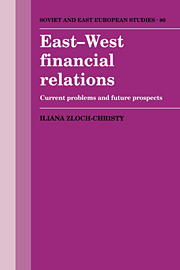Book contents
- Frontmatter
- Contents
- List of figures
- List of tables
- Acknowledgements
- List of abbreviations
- Introduction
- 1 Eastern Europe in a time of change
- 2 The Eastern European external debt situation
- 3 The financing of East-West trade
- 4 Medium- and long-term debt prospects in Eastern Europe
- Conclusion
- Epilogue
- Notes
- References
- Index
- Soviet and East European Studies
1 - Eastern Europe in a time of change
Published online by Cambridge University Press: 04 August 2010
- Frontmatter
- Contents
- List of figures
- List of tables
- Acknowledgements
- List of abbreviations
- Introduction
- 1 Eastern Europe in a time of change
- 2 The Eastern European external debt situation
- 3 The financing of East-West trade
- 4 Medium- and long-term debt prospects in Eastern Europe
- Conclusion
- Epilogue
- Notes
- References
- Index
- Soviet and East European Studies
Summary
Since 1985 Eastern Europe has been attempting to reform the centrally planned economic system. The present reforms are regarded by East European and Western scholars, businessmen and officials as the most radical reforms in the history of the CMEA economic mechanism in the recent thirty years. This chapter discusses the economic and political aspects of ‘perestroika’ and the main developments in reforming the foreign trade system and in creating capital markets in Eastern Europe.
Economic and political aspects of perestroika
The frequency of attempts to reform the CMEA centrally planned economic system and their reversal after the mid-1950s indicate the intensive pressure for change and the difficulty of its successful implementation. The present round of reforms involves the Soviet Union and four other Eastern European countries – Bulgaria, Czechoslovakia, Hungary and Poland. There are no signs of reform in the GDR and Romania. In the GDR the pressure for reform at present is considerably reduced by its ‘special relationship’ with West Germany and by its flexible vertically integrated economic structure. The GDR foreign trade system is decentralized and collectives play an important role in agriculture. However, the reunification of Germany in October 1990 puts the discussion on economic reform in East Germany in a completely different light from the reforms in the other East European countries. Romania is still firmly continuing to resist any change in its highly centralised economic bureaucratic system.
Pillars of the reform
The present reforms aim not only at changing priorities and changing policies as previous attempts did, but at changing the economic system.
- Type
- Chapter
- Information
- East-West Financial RelationsCurrent Problems and Future Prospects, pp. 3 - 29Publisher: Cambridge University PressPrint publication year: 1991

